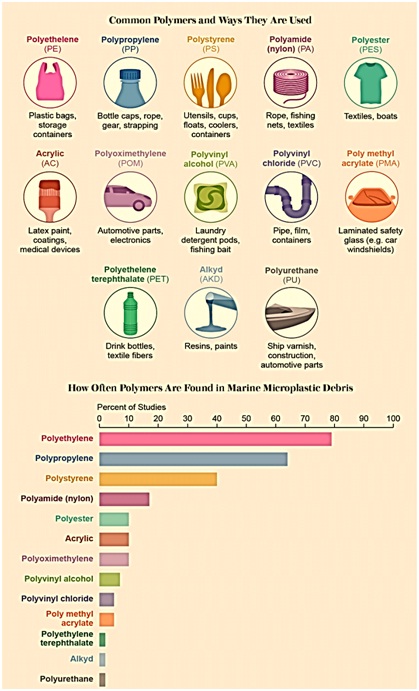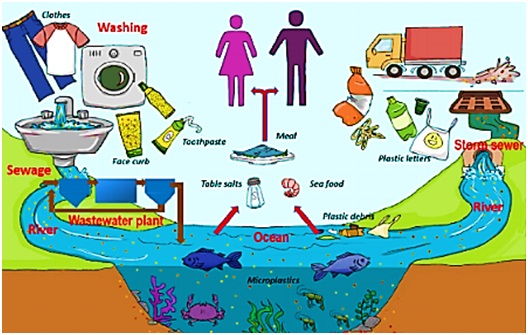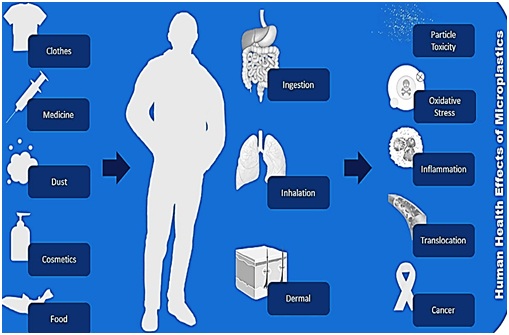Microplastic Pollution In Atlantic Ocean
- 20 Aug 2020
- Recently, a new study published in Nature Communications has estimated early 11.6-21.1 million tones amount of microplastic pollution in the Atlantic Ocean.
Key Findings
- In the study, scientists studied pollution of the Atlantic Ocean caused by three types of plastics: polyethylene, polypropylene, and polystyrene, which were suspended in the top 200 metres of the ocean. These three types of plastic are most commonly used for packaging.
- Smaller plastic particles are a hazard, as it is easier for them to sink to greater ocean depths and some marine species such as zooplanktons show preferential ingestion of smaller particles, making them easier to enter the food chain.
- They also estimate that based on plastic waste generation trends from 1950-2015 and considering that the Atlantic Ocean has received 0.3-0.8 per cent of the global plastic waste for 65 years, the Atlantic waters could hold 17-47 million tonnes of plastic waste.
- Analysis of water and sediment worldwide indicates that microplastics are ubiquitous in freshwater, marine ecosystems and soils.
Microplastics
- These are plastic debris smaller than 5mm in length, or about the size of a sesame seed.
- These particles are mostly made from polyethylene (PE), polypropylene (PP), polystyrene (PS), polyethylene terephthalate (PET) and polyesters.
- Microplastics come in a large variety of sizes, colours and chemical compositions, and include fibres, fragments, pellets, flakes, sheets or foams.
Categories
They can be divided into two main categories according to their source:
Primary Microplastics
- Directly released in the environment as small particles.
- Are estimated to represent between 15-31% of microplastics in the oceans.
- Main sources: Laundering of synthetic clothes (35% of primary microplastics); abrasion of tyres through driving (28%); intentionally added microplastics in personal care products, for example microbeads in facial scrubs (2%).
Secondary Microplastics
- Originate from degradation of larger plastic objects, such as plastic bags, bottles or fishing nets
- Account for 69-81% of microplastics found in the oceans.

How does plastic reach the oceans?
- Major sources of microplastics include:
- Agricultural runoff
- Aquaculture
- Cruise ships
- Ocean dumping
- Stormwater
- The shipping and fishing industries
- Urban runoff
- Waste management
- Wastewater treatment plants

Impact
Impact on Marine Ecosystem
- Many persistent organic pollutants (for example, pesticides, polychlorinated biphenyls-PCBs, DDT, and dioxins) float around the oceans at low concentrations, but their hydrophobic nature concentrates them on the surface of plastic particles.
- Marine animals mistakenly feed on the microplastics, and at the same time ingest the toxic pollutants. The chemicals accumulate in the animal tissues and then increase in concentration as the pollutants are transferred up the food chain.
- Besides the associated chemical loads, ingested plastic materials can be damaging for marine organisms, as they can lead to digestive blockage or internal damage from abrasion.
- Microfibres, which have been reported as the most abundant type of microplastics in wastewater and freshwaters, are of particular concern. They have been identified in the intestinal tract of zooplankton, river-bed organisms, and mussels. They can result in gut blockage and starvation.
Impact on Human Health
- For humans, too, marine plastic pollution is harmful if it reaches the food chain. For instance, microplastics have been found in tap water, beer and even salt.
- Plastic swallowed by fish, shellfish and crustaceans also ends up on our tables. So the effects are also felt by humans: the pollutants released by microplastics can be ingested and absorbed by humans. These can interfere with the human endocrine system and produce genetic modifications.
- Consumption of plastic by humans is harmful since several chemicals that are used to produce plastics can be carcinogenic.

|
Global Efforts to Control Use of Microplastics United States
Canada
Europe
China
India
|
Mitigation and Control Measures
Short-term Measures
- Regulation of production and consumption through bans or taxes of plastic products thatare harmful to the environment, without compromising public health or food safety.
- Reducing the consumption of plastics through removal of unnecessary packaging (e.g., double packaging), labelling, awareness, education, and by providing eco-friendlyalternatives to plastics when possible without unintended consequences.
- Increasing demand for recycled plastics through benefits, sanctions, or taxes on virgin plastics.
Mid-term Measures
- Implementation of waste collection systems that lead to reductions in waste production, improve recycling rates following the “pay-as-you-throw” principle, such as door-to-doorcollection and deposit-refund systems.
- Prioritizing recycling followed by feedstock and waste-to-energy that allow recovery of valuable chemicals and energy; landfill should only be used in waste produced in the previous processes.
- Reduction and recycling of waste formed during production and responsibility over wasteand impacts caused by products.
Long-term Measures
- Using renewable energy during collection of waste and recycling to reduce environmental impacts of recycled plastics.
- Implementing Life Cycle Assessment (LCA) for each product and process to improve eco-design (including reuse, repair, and recyclability), taking into consideration expected end-of-life of products.
- Using bio-based plastics to reduce environmental impacts from fuel-based plastics; reducing production of degradable plastics that produce harmful fragments (microplastics);using biodegradable plastics in applications where composting is beneficial (e.g., agriculturalfilms) while providing specific collection and waste treatment (since biodegradation maybe slower or not possible in the environment).
- Improving recyclability of e-waste and in the interim, disposal through waste-to-energy.
Way Forward
- An integrated waste management system, focused on the four R’s hierarchy (reduce, reuse, recycle, recover) and improving the life-cycle of plastics is important to reduce energy and resources consumptions, avoid harmful emissions, and reduce quantities of mismanaged plastic waste reaching the oceans.
- These measures require command and control and economic measures created by governments, voluntary measures from industries, and changesin consumer behavior.
- Since plastic marine litter knows no boundaries, international cooperation is the need of the hour in order to improve waste management systems in all countries (or at least coastal countries).


